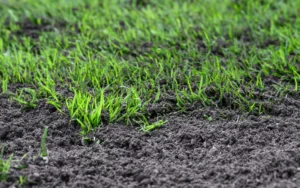Keeping a healthy lawn isn’t just about what you do right—it’s also about avoiding the stuff that quietly kills your grass behind the scenes. You might be following all the “top tips” you’ve read online, but still end up with bare patches, yellowing blades, or a lawn full of weeds.
Often, the problem isn’t that you’re not doing enough—it’s that you’re doing the wrong things.
1. Cutting Grass Too Short (“Scalping”)
It might be tempting to keep your grass short when mowing, but please don’t do that.
The mistake:
Mowing your lawn down to the lowest possible height in hopes of not needing to mow again for a while.
Why it’s bad:
This strips the lawn of its protective canopy, exposing the roots to sun, pests, and disease. It also weakens the grass, leaving it vulnerable to weed invasion.
What to do instead:
Follow the “one-third rule” — never cut more than a third of the grass blade in one go. Adjust your mower height with the season: higher in summer to protect from heat stress, lower in cooler months to encourage thicker growth.
2. Overwatering (or Underwatering)
Grass does need water, but there is such a thing as too much water.
The mistake:
Watering every day or not watering at all unless there’s a drought.
Why it’s bad:
Too much water encourages shallow roots, fungus, and pests. Too little water starves your grass and leaves it brittle and brown. Many homeowners just guess when the lawn needs water, which usually means it’s either drowned or dehydrated.
What to do instead:
Water deeply but less frequently—ideally 2–3 times a week in summer, early in the morning. Let the soil dry out slightly between sessions to encourage stronger root systems.

3. Using the Wrong Fertiliser
There are a lot of fertiliser options available in the market. The wrong one can lead to disastrous results.
The mistake:
Grabbing whatever fertiliser is on sale and throwing it on your lawn without checking the type or quantity.
Why it’s bad:
Different lawns have different needs. Over-fertilising can burn your grass and pollute nearby water systems. Under-fertilising leaves your lawn weak and yellow. Using the wrong mix for the season does more harm than good.
What to do instead:
Use a slow-release fertiliser suited to your grass type and the time of year. Read the label. Less is often more—apply evenly and water it in properly.
4. Ignoring Soil Quality
Not all lawn soils are the same.
The mistake:
Assuming the grass will thrive no matter what the soil underneath looks like.
Why it’s bad:
Poor soil leads to poor lawns. If it’s too compacted, acidic, or lacking in nutrients, even the best lawncare efforts won’t work.
What to do instead:
Get your soil tested—especially if you’ve been struggling to grow a healthy lawn. Add compost, adjust pH levels if needed, and aerate once a year. Healthy soil = healthy lawn.
5. Mowing With Blunt Blades
There’s a reason why lawnmower blades come sharpened.
The mistake:
Mowing with dull blades because you haven’t sharpened or replaced them in months (or years).
Why it’s bad:
Blunt blades tear the grass instead of slicing it cleanly. This causes ragged edges that brown quickly and are more susceptible to disease.
What to do instead:
Sharpen your mower blades at least once a season, or replace them if they’re too far gone. Sharp blades mean cleaner cuts and a neater lawn.

6. Letting Weeds Get Out of Control
The lawn isn’t going to mow itself.
The mistake:
Ignoring weeds until they’ve taken over half your yard—or worse, mowing over them and hoping they’ll just disappear.
Why it’s bad:
Weeds compete with grass for nutrients, water, and light. Left unchecked, they spread quickly and choke out your lawn. Mowing them just spreads the seeds.
What to do instead:
Spot-spray weeds early with the appropriate herbicide. Focus on lawn density through proper feeding and watering—thick, healthy grass naturally suppresses weeds.
7. Overusing Chemical Treatments
Some chemicals are fine when done in moderation.
The mistake:
Dousing your lawn with pesticides or herbicides at the first sign of trouble.
Why it’s bad:
Over-reliance on chemicals can damage soil health, kill beneficial insects, and lead to resistance in pests. It’s also not great for kids, pets, or local wildlife.
What to do instead:
Use treatments sparingly and only when necessary. Try preventative lawncare (like good mowing and watering habits) to reduce the need for chemical fixes. Consider organic or low-impact alternatives where possible.
Final Thoughts: Good Lawncare Is About Awareness, Not Just Action
Most lawn issues don’t come from neglect—they come from doing the wrong things with the best intentions. You mow, water, and fertilise thinking you’re doing right, but your lawn still struggles. That’s frustrating, and we get it.
But if you can avoid these common pitfalls, you’ll save time, money, and effort. Lawncare isn’t just about sticking to a routine—it’s about knowing what not to do.
Take the time to observe your lawn. Adjust your habits. And remember, the best lawncare is thoughtful, not rushed.





